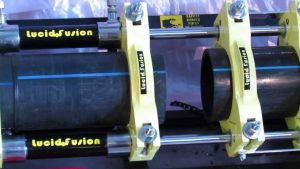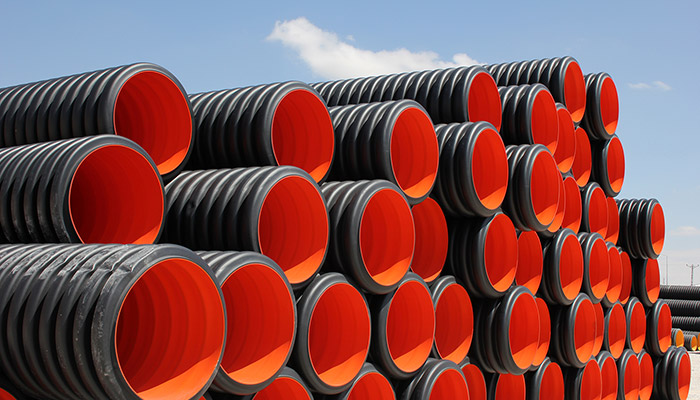Methods of connecting polyethylene pipes
In this article, we want to talk about the methods of connecting polyethylene pipes, as you know, since its inception in 1933, polyethylene has become one of the most well-known thermoplastic materials in the world. The versatility of this unique plastic material has been proven through its various applications. The initial use of polyethylene during World War II was as an alternative to plastic in electrical insulation. Today, polyethylene has become one of the most widely used thermoplastics in the world. Modern polyethylene resins are now being developed and designed for more serious applications such as gas pipes and high pressure water transfer projects, landfill processes, fuel tanks and other applications.
The use of polyethylene as a material for pipe production first occurred in the mid-1950s. The main use of polyethylene was in industrial applications, which was later followed in the oil and gas industry because these industries needed a light, durable and The success of polyethylene pipes in the mentioned industries led to the use of these pipes in the natural gas distribution network, because in these industries there was a need for a pipe that is resistant to corrosion and can deliver natural gas to homes without leakage. Estimates show that approximately 95% of new piping in North American gas distribution networks is for 12 ”diameters or smaller diameters made of polyethylene. Pipes have been used in plumbing installations such as drinking water distribution, mineral and industrial pipes, power lines and other serious applications.
Methods of connecting pipes
Polyethylene fittings by thermal welding or mechanical fittings
Because polyethylene is a thermoplastic material, polyethylene pipes and fittings can be produced by simultaneously applying heat and pressure, and by using heat welding processes at temperatures above the melting point of contact surfaces, polyethylene pipes can be permanently It boiled together.
Polyethylene pipes or fittings are joined together by heat welding or mechanical fittings. Polyethylene pipes can be connected to other pipes using pressure fittings, flanges and.. The user has many types of connections to choose from. Each of these connections has its own advantages and disadvantages in the specific connection conditions that the user encounters.
Regarding the connection of polyethylene pipes with each other and with fittings, it should be noted that first the pipes and fittings are standard, then standard equipment is used for connection, and finally the connection method by the contractors is principled and correct. The equipment used to perform the heat welding connection process must be specially designed to work with the pipe and the welding instructions. In addition, the equipment must be well maintained and capable of operating in accordance with the stated technical specifications.
Connection of polyethylene pipes by butt welding or BUTT WELD
This type of connection of polyethylene pipes is also called thermal connection, in this method, the two ends of polyethylene pipes are heate

d simultaneously before connection. This heat is generated by the hot plate and the temperature of the hot plate reaches about 210 degrees Celsius. During the heating and cooling stage, the parameters of time and mechanical pressure on the polyethylene pipe must be observed.
This type of connection is used for polyethylene pipes with the same outer diameter and similar wall thickness. Due to the tolerance in the wall thickness of spiral polyethylene pipes, which are produced based on the inner diameter, there may be problems in aligning and connecting the polyethylene pipes by butt welding method.
Electrofusion welding

Electrofusion welding is different from thermal melting welding. The main difference is in the method of heating the joint. In the method of thermal melting welding is a thermal tool to heat the joint. In hot melt welding method, thermal tools are used to heat the surface of pipes and polyethylene fittings, but in electrofusion welding, heat is generated internally through an electric current. In polyethylene pipes, the strength of the weld created by the electrofusion method is higher than that of the lead-melted weld.
Electrofusion welding is a method of welding polyethylene pipes and fittings that uses special fittings that have an electrical resistance wire to generate heat to melt the weld surfaces. Electric current is transmitted through the electrofusion welding machine and its control box to both ends of the connection. Like thermal melting welding methods, various types of saddle and socket connections are used in electrofusion method. The principles of the electrofusion welding process are the same for most electrofusion joints.
In electrofusion joints, the heating method is compared to butt fusion welding methods and electricity is used to generate heat. Due to its very high safety, this method is the only type of connection approved by the igs standard for gas transmission lines. Using this method, various polyethylene connections such as pipe-pipe, pipe-elbow, pipe-bushing and. Can be created. Therefore, the limitation of polyethylene butt welding method is not limited to connecting pipes with similar sizes. Experience has also shown that it is possible to connect polyethylene pipes with different types of polyethylene in this method. In addition to its safety, other advantages of this method are high speed and clean connection, but on the other hand, the limitation of this method is the high cost and maximum diameter of the pipe that can be connected with this method.
Connection of polyethylene pipes by extrusion welding method
This method is commonly used to connect polyethylene pipes with a size larger than 800 mm, to connect polyethylene pipes to Adamro and to make handmade fittings.
First, the edges of the two layers or polyethylene pipes and the connection are heated by a hair dryer, then the molten polyethylene material is injected between the two edges by a hand extruder. The material is fed in the form of a wire and is formed with the help of a special spatula. In this method, the skill and accuracy of the welder is important.
Extruder welding is the best way to connect polyethylene pipes in terms of sealing and mechanical strength, but this method requires more time than other methods and is not applicable to small diameters of polyethylene pipes.
Threaded fittings
Threaded fittings are used for small pipes (diameter between one eighth to 2 inches). The thread is available on the pipe up to a nominal diameter of 2 inches. There is also a larger threading tool, but it works using a gear reducer and requires a lot of manpower. Since threaded connections are made by machine or by hand The manufacturer’s recommendations must be followed carefully. The shape of the pipe threads must be such that it matches the shape of the fittings.
If the thread of the pipe is too long, it will remain open in front of the connection before the slope of the threads seals the connection. A properly connected pipe is sturdy and a thread will be seen above the connection. Anything more or less indicates that the threads are not properly machined.
